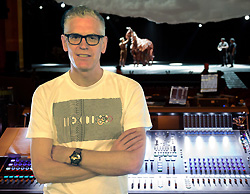
While at The National, he began working with Theatre de Complicite, a company he credits as instrumental to helping him develop his approach to sound design.
“With Complicite, you usually started with very little. It could be just the director saying, ‘I read an article in the paper about someone they found buried under the ice in the Alps the other day.’ Then I’d read around the subject, come up with ideas and the director would cherry pick from them, piece it together and come up with something compelling.
“That improvisatory approach to the application of sound was how I grew up, really, and I think I bring that aesthetic into other more conventional forms of theater.”
Shutt soon took on more sound design work in general and for Complicite specifically; so much so that his employer, the National, suggested he might be happier freelancing.
Eventually, although he enjoyed working at The National, he moved on, but only after receiving an offer in 2002 he simply couldn’t refuse: an opportunity to work on Simon McBurney’s production of The Resistible Rise of Arturo Ui at New York’s National Actors Theatre featuring Al Pacino, Steve Buscemi, and members of the cast of The Sopranos. “The music was by Tom Waits and it was just such a great chance. I either had to turn it down or leave the National.”
That proved to be a turning point. “I had transferred shows to New York before,” he says – including Not About Nightingales, which won the Drama Desk Award for Outstanding Sound Design in 2000 – “but the Simon McBurney production was the first time I was on my own.”
Developing What Works
Shutt’s musical background has always impacted his sound design. “Having been a drummer, I’ve got rhythm. So when I’m putting a show together, I tend to time sounds to the rhythm to ensure a seamless join between the sound effects, the samples and the music, and I expect operators to do the same.”
It’s an approach that has often been described as cinematic, particularly in relation to his work on War Horse. “The cinema is a popular art form, and I’m an audience member just like anybody else so I can’t help being influenced by it. A real watershed for me was Tim Burton’s The Nightmare Before Christmas. That film used surround sound in such an exciting way that it gave me loads of ideas. It was a revelation.”
Regardless of the type of show, his process is similar. “Essentially, I throw things into the mix, eliminate what doesn’t work and continue to develop what does. Getting my head around what’s needed six months ahead of time, before we’ve rehearsed, I’m not really into that. Some people plan rigorously well ahead, but I like to adapt to situations as I see them and to work with collaborators who are flexible.”
